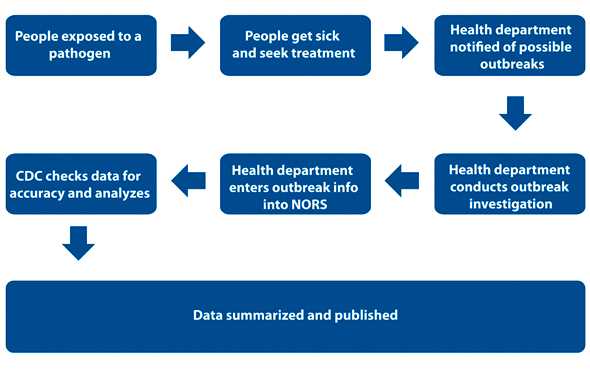Using NORS Data
Source of the Data
Most outbreaks in the United States are investigated by state, local, and territorial health departments. Outbreak information is then voluntarily reported to CDC by the public health agency that conducted the investigation. CDC may be involved in outbreak investigations that involve more than one state, that are particularly large, or for which the state or local health department requests assistance. The current reporting forms can be found on Forms & Guidance.
Data Collection Activities and Instruments
Foodborne and waterborne disease outbreaks have been reported to CDC since the 1970s. Reporting was expanded in 2009 to include all enteric disease outbreaks regardless of mode of transmission. The table below provides an overview of the types of outbreak data and the periods when the data were collected.
*FDOSS: Foodborne Disease Outbreak Surveillance System; pFORS: paper-based Foodborne Disease Outbreak Reporting System; eFORS: electronic-based Foodborne Disease Outbreak Reporting System; NORS: National Outbreak Reporting System; WBDOSS: Waterborne Disease and Outbreak Surveillance System
Note:
| Mode of Transmission | 1973—1997 | 1998—2008 | 2009—Present |
|---|---|---|---|
| Foodborne (FDOSS*) | pFORS* (paper form) |
eFORS* (electronic reporting) |
NORS* (electronic reporting) |
| Waterborne (WBDOSS*) | Paper form (began 1971)* | NORS | |
| Person-to-person | No systematic reporting | NORS | |
| Animal Contact | No systematic reporting | NORS | |
| Environmental | No systematic reporting | NORS | |
| Indeterminate/Unknown | No systematic reporting | NORS | |
Data Quality, Close-Out, & Dissemination
CDC epidemiologists routinely perform data quality and assurance procedures to validate key variables and identify possible errors. This process is referred to as “close-out.” Final data are typically available for release 12—18 months after the end of the reporting year; this allows states time to finalize reports and CDC to perform close-out. NORS is a dynamic system, and reports can be modified when new information is available, even months or years after data have been closed out.
How Outbreak Data are Reported to NORS and Summarized by CDC

Standard Data Restrictions
An outbreak reported to NORS is defined as the occurrence of two or more cases of a similar illness resulting from a common exposure. Data on specific reports might not be released if:
- the report does not meet the definition of an outbreak (e.g., only contains information on a single case of illness)
- the report has not been finalized by the state that reported it or has not been closed-out by CDC
Limitations
- Reporting of outbreaks to CDC is voluntary; outbreaks are likely underreported due to limited resources and training in health departments, which might vary by outbreak mode of transmission.
- Only a small proportion of illnesses reported each year are identified as associated with outbreaks. The extent to which the distribution of various sources and settings implicated in outbreaks reflects the same sources of infection and settings of sporadic illnesses is unknown.
- Outbreaks occurring on cruise ships and those where the exposure occurred outside the United States are not reported through NORS. For more information on cruise ship outbreaks, please visit the CDC’s Vessel Sanitation Program.
- Additional limitations may apply to the content or use of outbreak surveillance datasets.
Download NORS Data
- Foodborne Outbreak Online Database (FOOD) tool – a web-based platform for searching CDC's Foodborne Disease Outbreak Surveillance System database.
- Waterborne Disease & Outbreak Surveillance Reports - Published line lists of waterborne disease outbreaks beginning in 1971.
- NORS users are able to download report data for most types of outbreak reports within their reporting site using the Full Download and PDF Download features in the NORS interface.
- To request additional NORS or related historical data, or to obtain data for use in scientific publications, email the CDC NORS Team.
Analyze NORS Data
- NORS outbreaks (all modes)
- NORS Relational Data Dictionary [36 pages] (Updated March 2017)—A complete list of variables contained in the CDC 52.12 and 52.13 forms and downloadable by NORS users in a relational format
- NORS Flat Data Dictionary [40 pages] (Updated March 2017)—A complete list of variables contained in the CDC 52.12 and 52.13 forms and downloadable by NORS users in a flat format
- NORS 52.12 Flat Annotated Form [12 pages] (Added March 2017)—The CDC 52.12 form with markers that correspond to the flat data dictionary.
- NORS 52.12 Relational Annotated Form [12 pages] (Added March 2017)—The CDC 52.12 form with markers that correspond to the relational data dictionary.
- NORS 52.13 Annotated Form [7 pages] (Added March 2017)—The CDC 52.13 form with markers that correspond to the flat and relational data dictionaries.
- Page last reviewed: August 23, 2016
- Page last updated: February 22, 2017
- Content source:


 ShareCompartir
ShareCompartir